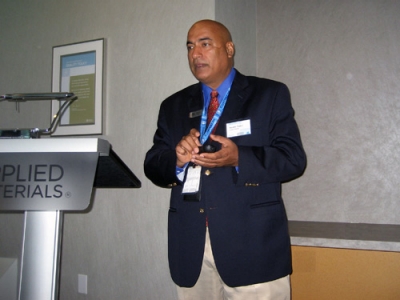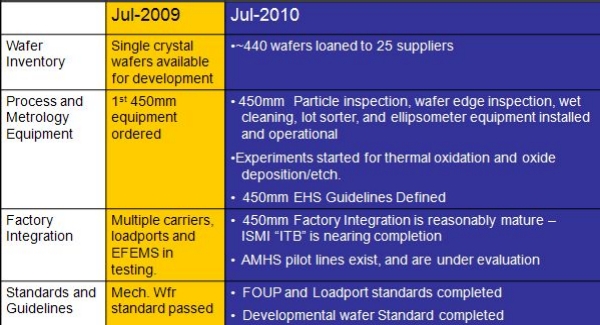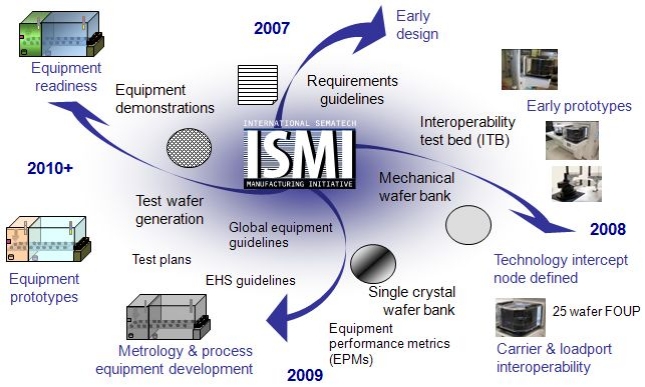by Michael A. Fury, Techcet Group
 July 20, 2010 – The third & final day of SEMICON West 2010 was quite a bit more relaxed with everyone crashing following their sugar highs at the NY Loves NanoTech dessert event the night before. Folks seemed more willing to just sit down and talk for a spell.
July 20, 2010 – The third & final day of SEMICON West 2010 was quite a bit more relaxed with everyone crashing following their sugar highs at the NY Loves NanoTech dessert event the night before. Folks seemed more willing to just sit down and talk for a spell.
Mike Ciesinski, president & CEO of the FlexTech Alliance (which now resides in SEMI HQ) gave me an update on the next quarterly workshop on flexible & printed electronics: Advanced Materials and Processes Enabling Thin Film PV R2R Nanomanufacturing, coming up Sep. 15-16 in New Bedford, MA.
Robert Rossi (VP) and John Welty (polishing manager) at Spartan Felt gave me a fascinating tour through the world of polishing pad applications and pad types beyond the domain of semiconductor CMP. It really is a humbling experience to see how much technology goes on outside of our semiconductor-centric world.
| SEE ALSO: |
| Day 2: Shoes vs. phones, CMP users, updating Art’s Law |
| Day 1: CMP, slurries, metrology, thermal, zombies, observations |
In my Day 2 blog, I promised some follow-up to some questions raised at the CMPUG Q&A. Some additional data and presentations can be found on the Confluense LLC Web site, and it is instructive to watch their video posted on YouTube. For anything else, I recommend contacting Confluense directly. The other subject that came up was the button pad from SemiQuest, which has posted some early data on its Web site — but the most recent information, including a description of the pad itself, is posted online with the May 2009 NCCAVS CMPUG proceedings, in a presentation called "Opportunities and Challenges in Developing a Low Defectivity Pad Platform".
It’s always fun to see things come full circle. Bob Roberts, who sold me my first (not the first) CMP polisher at IBM East Fishkill in ~1986, is now back in San Luis Obispo, CA as Strasbaugh‘s executive director of advanced technologies, after several years on the East Coast. He and the Strasbaugh team launched their new STB P300 CMP system at the show, targeting small-lot, high-mix manufacturing environments.
I wasn’t able to spend much time at the Intersolar events over at Moscone West this year, but I did get a personal tour of the eIQ Energy system for connecting solar panels in parallel instead of series, from QA manager Bob Sherrill. It’s instructive to watch their video on YouTube — apparently it’s a pretty big deal to be able to connect panels in parallel for overall system efficiency. It has the added benefit of being able to use panels from different vendors, even different technologies, in a single integrated system. One of their local demo sites is the Big O Tire shop in Dublin, CA.
One thing I noticed about the Intersolar show is that folks were walking around with beers at 1pm, which I choose to believe is an indication of just how well things are going for the solar power industry. Had I seen this in the semiconductor show, I would have had a completely different interpretation for the early afternoon drinking, a much sadder one.
Michael A. Fury, Ph.D, is senior technology analyst at Techcet Group, LLC, P.O. Box 29, Del Mar, CA 92014; e-mail [email protected].







 July 14, 2010 – The first day of SEMICON West 2010 kicked off with a keynote address by IBM’s Bernie Meyerson, who has become a perennial favorite at the podium. His talk, "From Ghz to systems to solutions; our industry in transition,"
July 14, 2010 – The first day of SEMICON West 2010 kicked off with a keynote address by IBM’s Bernie Meyerson, who has become a perennial favorite at the podium. His talk, "From Ghz to systems to solutions; our industry in transition,"